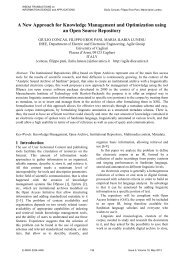Secured System against DDoS Attack in Mobile Adhoc ... - WSEAS
Secured System against DDoS Attack in Mobile Adhoc ... - WSEAS
Secured System against DDoS Attack in Mobile Adhoc ... - WSEAS
- No tags were found...
Create successful ePaper yourself
Turn your PDF publications into a flip-book with our unique Google optimized e-Paper software.
<strong>WSEAS</strong> TRANSACTIONS on COMMUNICATIONSArunmozhi Annamalai, Venkataramani Yegnanarayanan<strong>Secured</strong> <strong>System</strong> <strong>aga<strong>in</strong>st</strong> <strong>DDoS</strong> <strong>Attack</strong> <strong>in</strong> <strong>Mobile</strong> <strong>Adhoc</strong> NetworkARUNMOZHI ANNAMALAI, VENKATARAMANI YEGNANARAYANANDepartment of Electronics and Communication Eng<strong>in</strong>eer<strong>in</strong>gSaranathan College of Eng<strong>in</strong>eer<strong>in</strong>g, TrichyIndiasaarunmozhi@gmail.com http://www.saranathan.ac.<strong>in</strong>Abstract: - The risks to users of wireless technology have <strong>in</strong>creased as the service has become more popular.Due to the dynamically chang<strong>in</strong>g topology, open environment and lack of centralized security <strong>in</strong>frastructure, amobile ad hoc network (MANET) is vulnerable to the presence of malicious nodes and to ad hoc rout<strong>in</strong>gattacks. There are a wide variety of rout<strong>in</strong>g attacks that target the weakness of MANETs. This paper focuses onmobile ad hoc network's rout<strong>in</strong>g vulnerability and analyzes the network performance under two types ofattacks, flood<strong>in</strong>g attack and black hole attack that can easily be employed <strong>aga<strong>in</strong>st</strong> the MANETS. The resistiveschemes <strong>aga<strong>in</strong>st</strong> these attacks were proposed for Ad hoc on demand Distance Vector (AODV) rout<strong>in</strong>g protocoland the effectiveness of the schemes is validated us<strong>in</strong>g NS2 simulations.Key-Words: - Security, Defense, <strong>Mobile</strong> adhoc network, Denial of service, Flood<strong>in</strong>g attack, Black hole attack1 IntroductionA MANET is a self-configur<strong>in</strong>g network of mobiledevices connected by l<strong>in</strong>ks. Each device <strong>in</strong> aMANET is free to move <strong>in</strong>dependently <strong>in</strong> anydirection, and will therefore change its l<strong>in</strong>ks to otherdevices frequently. Each must forward trafficunrelated to its own use, and therefore be a router.The primary challenge <strong>in</strong> build<strong>in</strong>g a MANET isequipp<strong>in</strong>g each device to cont<strong>in</strong>uously ma<strong>in</strong>ta<strong>in</strong> the<strong>in</strong>formation required to properly route traffic. Suchnetworks may operate by themselves or may beconnected to the larger Internet. There are generallytwo types of ad hoc rout<strong>in</strong>g protocols, reactive andproactive rout<strong>in</strong>g protocols. The focus of this papercentres on reactive rout<strong>in</strong>g protocols which establishroutes between communicat<strong>in</strong>g nodes when neededus<strong>in</strong>g a route discovery process <strong>in</strong>volv<strong>in</strong>g RouteRequests and Route Replies, a process which can beeasily misused for denial-of-service attacks. Thetype of security attack <strong>in</strong> MANET is denial ofservice attack (DoS). A DoS attack is an attempt toprevent legitimate users of a service or networkresource from access<strong>in</strong>g that service or resource. ADistributed Denial-Of-Service (<strong>DDoS</strong>) attack is adistributed, large-scale attempt by malicious users toflood the victim network with an enormous numberof packets. This exhausts the victim network ofresources such as bandwidth, comput<strong>in</strong>g power, etc.The victim is unable to provide services to itslegitimate clients and network performance isgreatly deteriorated.The networks are particularly vulnerable toDoS attacks launched through compromised nodesor <strong>in</strong>truders. The <strong>in</strong>truder broadcasts mass RouteRequest packets or sends a lot of attack<strong>in</strong>g DATApackets to exhaust the communication bandwidthand node resources so that the valid communicationcannot be kept. In this paper, we have analyzed twotypes of attacks namely flood<strong>in</strong>g attack and blackhole attack <strong>in</strong> detail. The resist<strong>in</strong>g mechanisms overthese attacks are proposed and the effectiveness ofthe proposed schemes is validated with simulations.2 Security <strong>Attack</strong>s on MANETSThe ma<strong>in</strong> security services for MANETs areauthentication, confidentiality, <strong>in</strong>tegrity, nonrepudiationand availability. Authentication meansthat correct identity is known to communicat<strong>in</strong>gpartner; confidentiality means certa<strong>in</strong> message<strong>in</strong>formation is kept secure from unauthorized party;<strong>in</strong>tegrity means message is unaltered dur<strong>in</strong>g thecommunication; nonrepudiation means the orig<strong>in</strong> ofa message cannot deny hav<strong>in</strong>g sent the message;availability means the normal service provision <strong>in</strong>face of all k<strong>in</strong>ds of attacks.<strong>Attack</strong>s on MANETs come <strong>in</strong> manyvarieties and they can be classified based ondifferent aspects. Accord<strong>in</strong>g to the legitimate statusof a node, an attack could be external or <strong>in</strong>ternal.The external attacks are committed by nodes that arenot legal members of the network, while the <strong>in</strong>ternalattacks are from a compromised member <strong>in</strong>side thenetwork. The <strong>in</strong>ternal attacks are not easy to preventor detect. These attackers are aware of the securitystrategies, and are even protected by them. The<strong>in</strong>ternal attacks pose a higher threat to the network.In terms of <strong>in</strong>teraction, an attack could be passive orE-ISSN: 2224-2864 331 Issue 9, Volume 11, September 2012
<strong>WSEAS</strong> TRANSACTIONS on COMMUNICATIONSactive. Passive attacks do not disrupt thecommunication. Instead, they <strong>in</strong>tercept and capturethe packets to read the <strong>in</strong>formation. On the otherhand, active attackers <strong>in</strong>ject packets <strong>in</strong>to thenetwork to <strong>in</strong>terfere or <strong>in</strong>terrupt the networkcommunication, overload the network traffic; fakethe legitimate node or package, obstruct theoperation or cut off certa<strong>in</strong> nodes from theirneighbours so they cannot use the network serviceseffectively anymore.<strong>Attack</strong>s could also be classified accord<strong>in</strong>g tothe target layer <strong>in</strong> the protocol stack. By target<strong>in</strong>gthe physical layer of a wireless network or awireless node, an attacker can easily <strong>in</strong>tercept andread the message contents from open radio signals.An attacker can jam or <strong>in</strong>terfere the communicationby generat<strong>in</strong>g powerful transmissions to overwhelmthe target signals. The jamm<strong>in</strong>g signals do notfollow the protocol def<strong>in</strong>ition, and they can bemean<strong>in</strong>gless random noise and pulse. By target<strong>in</strong>gthe l<strong>in</strong>k layer, an attacker can generate mean<strong>in</strong>glessrandom packets to grab the channel and causecollisions. In this situation, if the impacted nodekeeps try<strong>in</strong>g to resend the packet, it will exhaust itspower supply; the attacker can passively eavesdropon the l<strong>in</strong>k layer packets; the l<strong>in</strong>k layer securityprotocol WEP is vulnerable too, the <strong>in</strong>itializationvector (IV) flaw <strong>in</strong> the WEP protocol makes iteasier for an attacker to launch a cryptanalytic typeattack. Com<strong>in</strong>g along with many new rout<strong>in</strong>gprotocols <strong>in</strong>troduced to the MANETs, many newtypes of attacks were presented to target thesespecific protocols. By target<strong>in</strong>g the transport layer,a desynchronization attacker can break an exist<strong>in</strong>gconnection between two nodes by send<strong>in</strong>gfabricated packets exceed<strong>in</strong>g the sequence numberto either node of the connection. It may result <strong>in</strong>lett<strong>in</strong>g the node keep send<strong>in</strong>g retransmissionrequests for the missed frames.By target<strong>in</strong>g on the application layer, aRepudiation attack is a threat to a bus<strong>in</strong>ess thatrelies on electronic traffic. Other application layerattacks, such as viruses, worms, trojans, spywares,backdoor, and data corruption or deletion, targeteither application layer protocols, such as FTP,HTTP, and SMTP, or applications and data files onthe victims.Some attacks target security leaks on thecryptography primitive of the protocols. Digitalsignature attacks target RSA public-key encryptionalgorithms. <strong>Attack</strong>ers forge the message signaturebased on the signature of a legitimate message.Digital signature attacks have three types, knownmessage,chosen message, and key only attacks. TheKnown-message attacker knows a list of messagesArunmozhi Annamalai, Venkataramani Yegnanarayananpreviously signed by the victim. The Chosenmessageattacker can choose a specific message thatit wants the victim to sign. The Key only attackerknows the public verification algorithm only.Hash collision attacks target hashalgorithms, such as SHA-1, MD4, MD5, HAVAL-128, and RIPEMD, to construct a valid certificatecorrespond<strong>in</strong>g to the hash collision. Pseudorandomnumber attacks reverse eng<strong>in</strong>eer the pseudorandomnumber generators used by the public keymechanisms to break the cryptography.3 BackgroundRout<strong>in</strong>g <strong>in</strong> MANETs is difficult s<strong>in</strong>ce mobilitycauses frequent network topology changes andrequires more robust and flexible mechanisms tosearch for and ma<strong>in</strong>ta<strong>in</strong> routes. When the networknodes move, the established paths may break andthe rout<strong>in</strong>g protocols must dynamically search forother feasible routes. Many protocols have beenproposed for MANETs. These protocols can bema<strong>in</strong>ly divided <strong>in</strong>to two categories as proactive andreactive protocols.Proactive Rout<strong>in</strong>g Protocols ma<strong>in</strong>ta<strong>in</strong> routesto all dest<strong>in</strong>ations, regardless of whether or not theseroutes are needed. In order to ma<strong>in</strong>ta<strong>in</strong> correct route<strong>in</strong>formation, a node must periodically send controlmessages. Therefore, proactive rout<strong>in</strong>g protocolsmay waste bandwidth s<strong>in</strong>ce control messages aresent out unnecessarily when there is no data traffic.The ma<strong>in</strong> disadvantages of such algorithms arerespective amount of data for ma<strong>in</strong>tenance and slowreaction on restructur<strong>in</strong>g and failures. The ma<strong>in</strong>advantage of this category of protocols is that hostscan quickly obta<strong>in</strong> route <strong>in</strong>formation and quicklyestablish a session. DSDV, OLSR and CGSR aresome of the well known proactive rout<strong>in</strong>g protocolsfor MANETs. Reactive protocols do not execute arout<strong>in</strong>g update until the communication needs it.When a route is needed, the source node <strong>in</strong>itiates aroute discovery process to the dest<strong>in</strong>ation. Onceestablished, the route must be ma<strong>in</strong>ta<strong>in</strong>ed until it isno longer needed or the dest<strong>in</strong>ation node becomes<strong>in</strong>accessible. Reactive rout<strong>in</strong>g protocols candramatically reduce rout<strong>in</strong>g overhead because theydo not need to search for and ma<strong>in</strong>ta<strong>in</strong> the routes onwhich there is no data traffic. This property is veryappeal<strong>in</strong>g <strong>in</strong> the resource-limited environment.AODV, DSR and TORA are some of the wellknown reactive protocols for MANETs.The AODV Rout<strong>in</strong>g Protocol is used forf<strong>in</strong>d<strong>in</strong>g a path to the dest<strong>in</strong>ation <strong>in</strong> an ad-hocnetwork. To f<strong>in</strong>d the path to the dest<strong>in</strong>ation allmobile nodes work <strong>in</strong> cooperation us<strong>in</strong>g the rout<strong>in</strong>gE-ISSN: 2224-2864 332 Issue 9, Volume 11, September 2012
<strong>WSEAS</strong> TRANSACTIONS on COMMUNICATIONScontrol messages. AODV Rout<strong>in</strong>g Protocol offersquick adaptation to dynamic network conditions,low process<strong>in</strong>g and memory overhead, low networkbandwidth utilization with small size controlmessages. The most dist<strong>in</strong>guish<strong>in</strong>g feature ofAODV compared to the other rout<strong>in</strong>g protocols isthat it uses a dest<strong>in</strong>ation sequence number for eachroute entry. The dest<strong>in</strong>ation sequence number isgenerated by the dest<strong>in</strong>ation when a connection isrequested from it. Us<strong>in</strong>g the dest<strong>in</strong>ation sequencenumber ensures loop freedom. AODV makes surethe route to the dest<strong>in</strong>ation does not conta<strong>in</strong> a loopand is the shortest path. Route Requests (RREQs),Route Replay (RREPs), Route Errors (RERRs) arecontrol messages used for establish<strong>in</strong>g a path to thedest<strong>in</strong>ation. When the source node wants to make aconnection with the dest<strong>in</strong>ation node, it broadcasts aRREQ message. This RREQ message is propagatedfrom the source, received by neighbours(<strong>in</strong>termediate nodes) of the source node. The<strong>in</strong>termediate nodes broadcast the RREQ message totheir neighbours. This process goes on until thepacket is received by dest<strong>in</strong>ation node or an<strong>in</strong>termediate node that has a fresh enough routeentry for the dest<strong>in</strong>ation. Sequence Numbers serveas time stamps and allow nodes to compare howfresh their <strong>in</strong>formation on the other node is.However when a node sends any type of rout<strong>in</strong>gcontrol message, RREQ, RREP, RERR etc., it<strong>in</strong>creases its own sequence number. Highersequence number is more accurate <strong>in</strong>formation andwhichever node sends the highest sequence number,its <strong>in</strong>formation is considered and route is establishedover this node by the other nodes. The sequencenumber is a 32-bit unsigned <strong>in</strong>teger value.4 Flood<strong>in</strong>g <strong>Attack</strong>4.1 RREQ Flood<strong>in</strong>g <strong>Attack</strong>Reactive rout<strong>in</strong>g protocols like AODV and DSR,used <strong>in</strong> MANETs, flood the network with routerequests whenever a new route is to be discovered.This technique of flood<strong>in</strong>g can be easily misused bymalicious nodes to disrupt the network. Generallyall nodes have a limit beyond which requests cannotbe sent. Malicious nodes can easily bypass this limitand send out large numbers of fabricated routerequests <strong>in</strong> the network. Flood<strong>in</strong>g RREQ packets <strong>in</strong>the whole network will consume a lot of resource ofnetwork. To reduce congestion <strong>in</strong> a network, theAODV protocol adopts some methods. A node cannot orig<strong>in</strong>ate more than RREQ_RATELIMIT RREQArunmozhi Annamalai, Venkataramani Yegnanarayananmessages per second. After broadcast<strong>in</strong>g a RREQ, anode waits for a RREP. If a route is not receivedwith<strong>in</strong> round-trip milliseconds, the node may tryaga<strong>in</strong> to discover a route by broadcast<strong>in</strong>g anotherRREQ, up to a maximum of retry times at themaximum TTL value. Repeated attempts by asource node at route discovery for a s<strong>in</strong>gledest<strong>in</strong>ation must utilize a b<strong>in</strong>ary exponentialbackoff. The first time a source node broadcasts aRREQ, it waits roundtrip time for the reception of aRREP. If a RREP is not received with<strong>in</strong> that time,the source node sends a new RREQ. Whencalculat<strong>in</strong>g the time to wait for the RREP aftersend<strong>in</strong>g the second RREQ, the source node MUSTuse a b<strong>in</strong>ary exponential backoff. Hence, the wait<strong>in</strong>gtime for the RREP correspond<strong>in</strong>g to the secondRREQ is 2 * round-trip time. The RREQ packets arebroadcast <strong>in</strong> an <strong>in</strong>crement<strong>in</strong>g r<strong>in</strong>g to reduce theoverhead caused by flood<strong>in</strong>g the whole network.In the Ad Hoc Flood<strong>in</strong>g <strong>Attack</strong> [10], theattack node violates the above rules to exhaust thenetwork resource. The attacker tries to sendexcessive RREQ without consider<strong>in</strong>gRREQ_RATELIMIT with<strong>in</strong> per second. Theattacker will resend the RREQ packets withoutwait<strong>in</strong>g for the RREP or round-trip time. In theFlood<strong>in</strong>g <strong>Attack</strong>s, the whole network will be full ofRREQ packets which the attacker sends. Thecommunication bandwidth is exhausted by theflooded RREQ packets and the resource of nodes isexhausted at the same time. For example, thestorage of route table is limited. If mass RREQpackets are com<strong>in</strong>g to the node <strong>in</strong> a little time, thestorage of route table <strong>in</strong> the node will exhaust sothat the node cannot receive new RREQ packet. Asa result, the legitimate nodes cannot set up paths tosend data.4.2 Data Flood<strong>in</strong>g <strong>Attack</strong>When nodes <strong>in</strong> MANET f<strong>in</strong>d the correct rout<strong>in</strong>gpath, source nodes send the data packets throughthat route. In data flood<strong>in</strong>g attack, the attacker firstma<strong>in</strong>ta<strong>in</strong>s the routes to dest<strong>in</strong>ation node, then sendsfrequently the useless data packets. The dest<strong>in</strong>ationnode will then be engaged <strong>in</strong> receiv<strong>in</strong>g the excessivedata packets from the attacker and cannot workproperly. The attacker packets engage the networkand stop the process<strong>in</strong>g of legitimate data packets.5 Black hole <strong>Attack</strong>A black hole attack is a type of denial of serviceattack accomplished by dropp<strong>in</strong>g packets. In blackE-ISSN: 2224-2864 333 Issue 9, Volume 11, September 2012
<strong>WSEAS</strong> TRANSACTIONS on COMMUNICATIONS3.3. RREQ rate < LTIdentify the node which forwards thisRREQ packet as Normal Node4. Else RREQ rate < UT4.1 Identify the forward<strong>in</strong>g node as theSuspicious Node (SN).4.2 RREQ packet is delayed <strong>in</strong> a queue.5. ElseIdentify the node as <strong>Attack</strong><strong>in</strong>g Node (AN).6. Endif7. AN is blocked from the network.6.1.2 Algorithm II1. Different flows are transmitted fromdifferent sources to dest<strong>in</strong>ations.2. FIMT stores the <strong>in</strong>formation of each flow.3. From FIMT, the assigned rate AR ij iscalculated for each flow.4. Intermediate nodes send updated FIMT ofall flows to dest<strong>in</strong>ation.5. If congestion is detected, distributed ratecontrol is applied and the actual rate of eachflow is assigned as ACR ij6. At the time <strong>in</strong>terval T, the measured datarate is noted.7. if MR ij > ACR ij , then7.1. Source status = REJECTED7.2. <strong>Attack</strong>er address = Source IP address8. End if9. If source status = REJECTED, then9.1 Remove the node from the list.9.2 Block all the traffic from the attacker10. End if.6.2 Defense Scheme Aga<strong>in</strong>st Black hole<strong>Attack</strong>To resist the black hole attack, we propose a defensemechanism which could be potentially exploited bymalicious nodes. A Neighbourhood RouteMonitor<strong>in</strong>g Table (NRMT) is ma<strong>in</strong>ta<strong>in</strong>ed by eachnode <strong>in</strong> the network. The NRMT ma<strong>in</strong>ta<strong>in</strong>s packetrout<strong>in</strong>g <strong>in</strong>formation of its neighbour nodes. Itconta<strong>in</strong>s the source ID, dest<strong>in</strong>ation ID, sourcesequence number, dest<strong>in</strong>ation sequence number, anda threshold value of sequence number which isdynamically updated, the time at which RREQpacket enters the node (RREQ-IN-TIME), the timeat which RREQ packet leaves the node (RREQ-OUT-TIME), the time at which RREP packet entersthe node (RREP-IN-TIME) and the time at whichRREP packet leaves the node (RREP-OUT-TIME).If the node is the normal node, once it receives theRREQ packet, it checks its rout<strong>in</strong>g table to identifywhether it is the dest<strong>in</strong>ation or not. Accord<strong>in</strong>g toArunmozhi Annamalai, Venkataramani YegnanarayananAODV protocol, if it is the dest<strong>in</strong>ation node, it willsend the RREP packet to the source node through itsroute or it will forward the RREQ to its one hopneighbour. Check<strong>in</strong>g the rout<strong>in</strong>g <strong>in</strong>formation fromthe table requires a m<strong>in</strong>imum time period known asMIN-TIME. If the node is the black hole node, itwill send a RREP message without check<strong>in</strong>g thetable. The NRMT ma<strong>in</strong>ta<strong>in</strong>s the record of the timeof Reply.The first step of the detection process isbased on the tim<strong>in</strong>g <strong>in</strong>formation of NRMT. Everynode <strong>in</strong> the network when it receives the RREPfrom its neighbour, f<strong>in</strong>ds DIFF-TIME which is thedifference between the RREQ-OUT-TIME andRREP-IN-TIME and compares this with MIN-TIME. If the RREP is from the black hole nodeDIFF-TIME will be less than the MIN-TIME. Thenode is identified as a suspicious node.It is well known that the black hole nodeassigns a high sequence number to settle <strong>in</strong> therout<strong>in</strong>g table of the victim node, before other nodessend a true one. As the second step of detectionmechanism, RREPs sequence number is comparedwith the threshold value of sequence number. In thisprotocol, the threshold value is dynamically updatedat every time <strong>in</strong>terval. If the current sequencenumber is greater than the threshold value the nodeis confirmed as black hole and it is elim<strong>in</strong>ated fromthe rout<strong>in</strong>g table. Once a node is detected to bereally malicious, the scheme has a notificationmechanism for send<strong>in</strong>g messages to all the nodesthat are not yet suspected to be malicious, so that themalicious node can be isolated and not allowed touse any network resources.7 Simulation and ResultsThe network simulator ns2 is used to simulate theexperiment. The parameter sett<strong>in</strong>gs for thesimulations are: the radio propagation mode is TwoRay Ground, antenna type is Omni antenna,<strong>in</strong>terface queue length is 50 (packets), queuemanagement scheme is Drop Tail, rout<strong>in</strong>g protocolis AODV, height of antenna is 1.5m, transmissiondistance is 250m, signal <strong>in</strong>terference or sens<strong>in</strong>gdistance is 550m. The speed of the mobile node is10m/s. The simulated traffic is Constant Bit Rate(CBR). The network covers the simulated area of1200m x 1200m.7.1 Simulation Implementation andEvaluation for flood<strong>in</strong>g attackE-ISSN: 2224-2864 335 Issue 9, Volume 11, September 2012
<strong>WSEAS</strong> TRANSACTIONS on COMMUNICATIONSArunmozhi Annamalai, Venkataramani YegnanarayananThe performance of our proposed scheme <strong>aga<strong>in</strong>st</strong>RREQ flood<strong>in</strong>g attack is analyzed for MANET withand without defence scheme. The protocol wasimplemented and evaluated <strong>in</strong> the ns-2 networksimulation environment. Number of nodes is avary<strong>in</strong>g parameter as it plays important role <strong>in</strong>network performance. The packet delivery ratio isthe ratio of the number of packets receivedsuccessfully to the total number of packets sent. Fig.1 shows how the packet delivery ratio (PDR) isvaried by vary<strong>in</strong>g the number of nodes to accountfor system scalability. It is seen that the PDR wasimproved up to 76.9% when our protocol wasimplemented. The pause time was also varied andthe PDR was obta<strong>in</strong>ed. Pause time can be def<strong>in</strong>ed astime for which nodes waits on a dest<strong>in</strong>ation beforemov<strong>in</strong>g to other dest<strong>in</strong>ation. Low pause time meansnode will wait for less time thus giv<strong>in</strong>g rise to highmobility scenario. Our simulations from Fig. 2 showhow PDR is varied by vary<strong>in</strong>g the pause time of anode <strong>in</strong> the network. It is clear that PDR <strong>in</strong>creasesas pause time <strong>in</strong>creases. This is because lowmobility allows more stable rout<strong>in</strong>g paths. However,it is not possible to achieve 100% packet deliverydue to the unreliable l<strong>in</strong>ks <strong>in</strong> wireless networks.Fig.3 and Fig. 4 show the performance ofour proposed work <strong>aga<strong>in</strong>st</strong> data flood<strong>in</strong>g attack. Allthe source nodes negotiate a rate of 100 kbps fortraffic flow and beg<strong>in</strong> send<strong>in</strong>g traffic on flow at arate of 100 kbps at time t = 1.0 sec. The attack<strong>in</strong>gflow is set at a rate of 500 kbps. The capacity of thel<strong>in</strong>k is set to 2 Mbps. It is seen that PDR is muchimproved with our proposed scheme. Our protocolconfirms the ability to provide resistance <strong>aga<strong>in</strong>st</strong>data flood<strong>in</strong>g attacks.Fig.2 Impact of defense scheme <strong>aga<strong>in</strong>st</strong> RREQflood<strong>in</strong>g attack with vary<strong>in</strong>g pause time.Fig.3 Impact of defense scheme <strong>aga<strong>in</strong>st</strong> dataflood<strong>in</strong>g attack with simulation timeFig.1 Impact of defense scheme <strong>aga<strong>in</strong>st</strong> RREQflood<strong>in</strong>g attack with vary<strong>in</strong>g number of nodesFig.4 Impact of defense scheme <strong>aga<strong>in</strong>st</strong> dataflood<strong>in</strong>g attack with vary<strong>in</strong>g number of attackersE-ISSN: 2224-2864 336 Issue 9, Volume 11, September 2012
<strong>WSEAS</strong> TRANSACTIONS on COMMUNICATIONS7.2 Simulation Implementation andEvaluation for black hole attackTo defend <strong>aga<strong>in</strong>st</strong> the black hole attack <strong>in</strong> MANET,the NRMT protocol was implemented and evaluated<strong>in</strong> the ns-2 network simulation environment. Wehave implemented the simulation of MANET with 2different cases. In the first case, we have established2 UDP traffic flows with the data rate of 50kbps andthe packet size of 512 bytes. We have implementedan AODV protocol that simulates the behaviour of ablack hole and we simulated 50 scenarios each<strong>in</strong>volv<strong>in</strong>g different ad-hoc networks with 30 nodeseach mov<strong>in</strong>g randomly. We have <strong>in</strong>troduced a blackhole <strong>in</strong> each scenario and compared the performanceof the networks with and without a black hole. Wethen implemented the NRMT method to detect anddiscard the black hole node.The performance of the network isevaluated based on the packet delivery ratio. Theeffect of black hole attack <strong>in</strong> AODV and the effectof NRMT method are observed from Fig. 5. S<strong>in</strong>cethe black hole attack is effectively detected based onNRMT, it can be <strong>in</strong>formed to all the other nodes <strong>in</strong>the network immediately. Hence the attack isremoved easily from the network. This follows thatthe number of successfully received packets get<strong>in</strong>creased and it improves the packet delivery ratio.However, the packet delivery ratio for the AODVprotocol without attack will be more for any numberof nodes <strong>in</strong> the network.The average end-to-end delay calculates thedelay of all the packets that have been successfullytransmitted from the source to the dest<strong>in</strong>ation. It<strong>in</strong>cludes all possible delays caused by buffer<strong>in</strong>gdur<strong>in</strong>g route discovery latency, queu<strong>in</strong>g <strong>in</strong> the<strong>in</strong>terface queue, retransmission delays at the MAC,propagation, and transfer times. In the proposedscheme we have adopted the 2 step procedure todetect the attack. Hence the average end to enddelay for the NRMT scheme is greater than theother two cases. The effect of average end to enddelay is shown <strong>in</strong> Fig.6.The number of rout<strong>in</strong>g packets transmittedper data packet delivered at the dest<strong>in</strong>ation. Eachhop-wise transmission of a rout<strong>in</strong>g packet is countedas one transmission. The rout<strong>in</strong>g load metricevaluates the efficiency of the rout<strong>in</strong>g protocol. Therout<strong>in</strong>g overhead is also evaluated with vary<strong>in</strong>gnumber of nodes. The overhead with the defensescheme is greater than the black hole attack case.This is because of the control packets that are sent tothe nodes <strong>in</strong> the network by the node which detectsthe black hole. But the rout<strong>in</strong>g overhead required forNRMT method is less than that required for theAODV protocol without attack. The effects ofrout<strong>in</strong>g overhead are shown <strong>in</strong> Fig. 7.In the second case of simulation the numberof UDP flows is varied. The packet delivery ratio,average end to end delay and rout<strong>in</strong>g overhead areevaluated. The impact is shown from Fig. 8 to Fig.10. It is observed that the proposed scheme givesbetter packet delivery ratio than the black holeattack case. But the average end to end delay andthe rout<strong>in</strong>g overhead are greater than the black holeattack case.Packet Delivery Ratio1.210.80.60.40.2Packet Delivery Ratio Vs Number of Nodes010 20 30 40 50Number of NodesblackholeproposedaodvFig.5 Impact of Packet Delivery Ratio with vary<strong>in</strong>gNo. of NodesDelay (sec)0.250.20.150.10.05Delay Vs Number of Nodes010-0.0520 30 40 50Number of NodesblackholeproposedaodvFig. 6 Impact of Average End to End Delay withvary<strong>in</strong>g No. of NodesRout<strong>in</strong>g OverheadArunmozhi Annamalai, Venkataramani Yegnanarayanan80000700006000050000Rout<strong>in</strong>g Overhead Vs Number of Nodes40000300002000010000010 20 30 40 50Number of NodesblackholeproposedaodvFig. 7 Impact of Rout<strong>in</strong>g Overhead with vary<strong>in</strong>g No.of NodesE-ISSN: 2224-2864 337 Issue 9, Volume 11, September 2012
Packet Delivery Ratio1.210.80.60.40.2Packet Delivery Ratio Vs No. of Flows02 4 6 8 10No. of FlowsblackholeproposedaodvFig. 8 Impact of Packet Delivery Ratio with vary<strong>in</strong>gNo. of FlowsDelay(sec)0.040.0350.030.0250.020.0150.010.0050Delay Vs No. of Flows2 4 6 8 10No. of FlowsblackholeproposedaodvFig. 9 Impact of Average End to End Delay withvary<strong>in</strong>g No. of FlowsRout<strong>in</strong>g Overhead<strong>WSEAS</strong> TRANSACTIONS on COMMUNICATIONS160000140000120000100000800006000040000200000Rout<strong>in</strong>g Overhead Vs No. of Flows2 4 6 8 10No. of FlowsblackholeproposedaodvFig. 10 Impact of Rout<strong>in</strong>g Overhead with vary<strong>in</strong>gNo. of Flows8 Related WorkArunmozhi S.A. and Venkataramani Y. [1] haveproposed the Flow Monitor<strong>in</strong>g (FMON) scheme forMANETs that is resistant to the Reduction ofQuality (RoQ) attack. RoQ attack is a new style of<strong>DDoS</strong> attack which is difficult to detect. RoQattacks throttle the TCP throughput heavily andreduce the QoS to end systems gradually rather thanArunmozhi Annamalai, Venkataramani Yegnanarayananrefus<strong>in</strong>g the clients from the services completely.The FMON protocol employs MAC layer-baseddetection scheme and a response scheme based onExplicit Congestion Notification (ECN) mark<strong>in</strong>g.The scheme requires each node to ma<strong>in</strong>ta<strong>in</strong> state<strong>in</strong>formation for each aggregate <strong>in</strong> out traffic streamtravers<strong>in</strong>g an <strong>in</strong>put-output pair, as opposed to everyflow, thus mak<strong>in</strong>g the scheme more scalable. Eachnode performs rate monitor<strong>in</strong>g/adjustment functionson each <strong>in</strong> out stream to prevent DoS conditions.When a node experiences congestion due to attackflow, ECN mechanism helps the legitimate sender toreduce the send<strong>in</strong>g rate. If the channel cont<strong>in</strong>ues tobe congested, updated FMON helps to detect theattackers and reject the attack<strong>in</strong>g flows. This makesthe network resources available to the legitimateusers. FMON protocol confirms the ability toprovide resistance <strong>aga<strong>in</strong>st</strong> RoQ <strong>DDoS</strong> attacks.Jelena Mirkovic and Peter Reiher [2] haveproposed a source-end <strong>DDoS</strong> defense system thatachieves autonomous attack detection and adaptiveresponse at the source-end. P<strong>in</strong>g Yi et al. [3] havedeveloped Flood<strong>in</strong>g <strong>Attack</strong> Prevention (FAP), ageneric defense <strong>aga<strong>in</strong>st</strong> the Ad Hoc Flood<strong>in</strong>g <strong>Attack</strong><strong>in</strong> mobile ad hoc networks. The FAP is composed ofneighbour suppression and path cutoff. When the<strong>in</strong>truder broadcasts exceed<strong>in</strong>g packets of RouteRequest, the immediate neighbours of the <strong>in</strong>truderobserve a high rate of Route Request and then theylower the correspond<strong>in</strong>g priority accord<strong>in</strong>g to therate of <strong>in</strong>com<strong>in</strong>g queries. M<strong>in</strong>g-Yang Su [7] hasproposed several <strong>in</strong>trusion detection system (IDS)nodes which are deployed <strong>in</strong> MANETs <strong>in</strong> order todetect and prevent selective black hole attacks. TheIDS nodes estimate a suspicious value of a nodeaccord<strong>in</strong>g to the abnormal difference between therout<strong>in</strong>g messages transmitted from the node.Supranamaya Ranjan et al. [8] have proposed acounter-mechanism called <strong>DDoS</strong> Shield <strong>aga<strong>in</strong>st</strong><strong>DDoS</strong> attack that consists of a suspicion assignmentmechanism and a <strong>DDoS</strong>-resilient scheduler.Zhiqiang GAO and Zhiqiang [15] have proposed atechnique to defend <strong>aga<strong>in</strong>st</strong> distributed denial ofservice attacks based on TCP. It uses proactive teststo identify and isolate the malicious traffic. ElmarGerhards-Padilla et al. [17] proposed a centralisedapproach, us<strong>in</strong>g topology graphs to identify nodesattempt<strong>in</strong>g to create a black hole. It performsplausibility checks of the rout<strong>in</strong>g <strong>in</strong>formationpropagated by the nodes <strong>in</strong> the network. An alarm istriggered if the plausibility check fails.E-ISSN: 2224-2864 338 Issue 9, Volume 11, September 2012
<strong>WSEAS</strong> TRANSACTIONS on COMMUNICATIONS9 ConclusionSecurity is an important feature for widedeployment of MANET. A variety of attacks havebeen discussed. In this paper, we have analyzed twotypes of <strong>DDoS</strong> attacks such as flood<strong>in</strong>g attack andblack hole attack. Defense scheme <strong>aga<strong>in</strong>st</strong> RREQflood<strong>in</strong>g attack based on b<strong>in</strong>ary exponential backoffand RREQ_RATELIMIT was proposed. Forresist<strong>in</strong>g the data flood<strong>in</strong>g attack, a FIMT schemewas developed based on the flow <strong>in</strong>formation. Theattackers are effectively identified with the proposedscheme. We have also described the black holeattack that can be mounted <strong>aga<strong>in</strong>st</strong> a MANET, andproposed a feasible solution for it on the top ofAODV protocol to avoid the black hole attack, andalso prevented the network form further maliciousbehaviour. We have developed a NRMT scheme forMANETs that is resistant to the black hole attack.The scheme identifies the attacker based on tim<strong>in</strong>g<strong>in</strong>formation and dest<strong>in</strong>ation sequence number.Hence a secure rout<strong>in</strong>g is provided with theproposed solution. Simulation is carried out us<strong>in</strong>gNS2. Simulation results validate the effectiveness ofour proposed schemes. The experimental resultsprove that the proposed solution improves thenetwork performance. The proposed defensemechanisms can also be applied for secur<strong>in</strong>g thenetwork from other rout<strong>in</strong>g attacks by chang<strong>in</strong>g thesecurity parameters <strong>in</strong> accordance with the nature ofthe attacks. As a future work, we plan to experimentthe proposed scheme for secur<strong>in</strong>g the network withother rout<strong>in</strong>g protocols and also to experiment thescheme for Prevent<strong>in</strong>g Cooperative <strong>Attack</strong>s <strong>in</strong><strong>Mobile</strong> Ad Hoc Networks.References:[1] S.A.Arunmozhi and Y.Venkataramani, A FlowMonitor<strong>in</strong>g Scheme to Defend Reduction-of-Quality (RoQ) <strong>Attack</strong>s <strong>in</strong> <strong>Mobile</strong> Ad-hocNetworks, Information Security Journal: AGlobal Perspective, Vol.19, No.5, 2010, pp.263- 272.[2] Jelena Mirkovic and Peter Reiher, D-WARD: ASource-End Defense <strong>aga<strong>in</strong>st</strong> Flood<strong>in</strong>g Denialof-Service<strong>Attack</strong>s, IEEE Transactions OnDependable And Secure Comput<strong>in</strong>g, Vol. 2, No.3, 2005, pp. 216-232.[3] P<strong>in</strong>g Yi, Zhoul<strong>in</strong> Dai, YiP<strong>in</strong>g Zhong andShiyong Zhang, Resist<strong>in</strong>g Flood<strong>in</strong>g <strong>Attack</strong>s <strong>in</strong>Ad Hoc Networks, Proceed<strong>in</strong>gs of theInternational Conference on InformationTechnology: Cod<strong>in</strong>g and Comput<strong>in</strong>g (ITCC'05),Vol. 2.Arunmozhi Annamalai, Venkataramani Yegnanarayanan[4] Hyoj<strong>in</strong> Kim, Ramachandra Bhargav Chitti, andJooSeok Song, Novel Defense Mechanism<strong>aga<strong>in</strong>st</strong> Data Flood<strong>in</strong>g <strong>Attack</strong>s <strong>in</strong> Wireless AdHoc Networks, IEEE Transactions onConsumer Electronics, Vol. 56, No. 2, May2010, pp. 579-582.[5] N. Karthikeyan, V. Palanisamy and K.Duraiswamy, Optimum Density Based Modelfor Probabilistic Flood<strong>in</strong>g Protocol <strong>in</strong> <strong>Mobile</strong>Ad Hoc Network, European Journal ofScientific Research, Vol.39, No.4, 2010,pp.577-588.[6] Xuan Yu, A Defense <strong>System</strong> On Ddos <strong>Attack</strong>sIn <strong>Mobile</strong> Ad Hoc Networks, Ph.D dissertation,Auburn University, Alabama, May 2007.[7] M<strong>in</strong>g-Yang Su, Prevention of selective blackhole attacks on mobile ad hoc networks through<strong>in</strong>trusion detection systems, ComputerCommunications, Vol. 34, 2011, pp. 107–117.[8] Supranamaya Ranjan, Ram Swam<strong>in</strong>athan,Mustafa Uysal, Antonio Nucci and EdwardKnightly, <strong>DDoS</strong>-Shield: <strong>DDoS</strong>-ResilientSchedul<strong>in</strong>g to Counter Application Layer<strong>Attack</strong>s, IEEE/ACM Transactions OnNetwork<strong>in</strong>g, Vol. 17, No. 1, February 2009, pp.26-39.[9] Amey Shevtekar and Nirwan Ansari, A routerbasedtechnique to mitigate reduction of quality(RoQ) attacks, Computer Networks, Vol. 52,2008, pp. 957–970.[10] P<strong>in</strong>g Yi, Zhoul<strong>in</strong> Dai, Shiyong Zhang andYip<strong>in</strong>g Zhong, A New Rout<strong>in</strong>g <strong>Attack</strong> <strong>in</strong><strong>Mobile</strong> Ad Hoc Networks, InternationalJournal of Information Technology, Vol. 11,No. 2, 2005, pp.83-94.[11] Michele Nogueira Lima, Aldri Luiz dosSantos and Guy Pujolle, A Survey ofSurvivability <strong>in</strong> <strong>Mobile</strong> Ad Hoc Networks,IEEE Communications Surveys & Tutorials,Vol. 11, No. 1, 2009, pp. 66-77.[12] S.Sanyal, A.Abraham, D. Gada, R.Gogri,P.Rathod, Z.Dedhia and N.Mody, Securityscheme for distributed DoS <strong>in</strong> mobile adhocnetworks. ACM, New York, 2004.[13] H. Deng, W. Li and D.P.Agrawal, Rout<strong>in</strong>gsecurity <strong>in</strong> wireless ad hoc networks, IEEECommunications Magaz<strong>in</strong>e, Vol. 40, No. 10,2002, pp. 70- 75.E-ISSN: 2224-2864 339 Issue 9, Volume 11, September 2012
<strong>WSEAS</strong> TRANSACTIONS on COMMUNICATIONSArunmozhi Annamalai, Venkataramani Yegnanarayanan[14] P.Eb<strong>in</strong>ger and M.Parsons, Measur<strong>in</strong>g theImpact of <strong>Attack</strong>s on the Performance of <strong>Mobile</strong>Ad hoc Networks, ACM PE-WASUN:Proceed<strong>in</strong>gs of the 6th ACM InternationalSymposium on Performance Evaluation ofWireless Ad Hoc, Sensor, and UbiquitousNetwork, 2009.[15] Zhiqiang Gao and Zhiqiang, Differentiat<strong>in</strong>gMalicious <strong>DDoS</strong> <strong>Attack</strong> Traffic from NormalTCP Flows by Proactive Tests, IEEECommunications Letters, Vol. 10, No. 11, 2006,pp. 793-795.[16] Junhai Luo, M<strong>in</strong>gyu Fan and Danxia Ye,Black Hole <strong>Attack</strong> Prevention Based onAuthentication Mechanism, 11th IEEES<strong>in</strong>gapore International Conference onCommunication <strong>System</strong>s, 2008, pp.173-177.[17] Elmar Gerhards Padilla, Nils Aschenbruck,Peter Mart<strong>in</strong>i, Marko Jahnke, and Jens T¨olle,Detect<strong>in</strong>g Black Hole <strong>Attack</strong>s <strong>in</strong> TacticalMANETs us<strong>in</strong>g Topology Graphs, Proceed<strong>in</strong>gsof 32nd IEEE Conference on Local ComputerNetworks, 2007, pp. 1043-1052.[18] M.Al-Shurman, S.Yoo and S.Park, Blackhole <strong>Attack</strong> <strong>in</strong> <strong>Mobile</strong> Ad Hoc Networks. ACMSoutheast Regional Conference, 2004, pp. 96-97.[19] Jiey<strong>in</strong>g Zhou, Junwei Chen and Huip<strong>in</strong>gHu, SRSN: Secure Rout<strong>in</strong>g based on SequenceNumber for MANETs, InternationalConference on Wireless Communications,Network<strong>in</strong>g and <strong>Mobile</strong> Comput<strong>in</strong>g, 2007,pp.1569-1572.[20] Nital Mistry, Devesh C J<strong>in</strong>wala andMukesh Zaveri, Improv<strong>in</strong>g AODV Protocol<strong>aga<strong>in</strong>st</strong> Blackhole <strong>Attack</strong>s, Proceed<strong>in</strong>gs of theInternational Multiconference of Eng<strong>in</strong>eers andComputer Scientist, Hong Kong, Vol. II, 2010.[21] Z.Gao and N.Anzari, Differentiat<strong>in</strong>gmalicious <strong>DDoS</strong> attack traffic from normal TCPflows by proactive tests, IEEE CommunicationsLetters, Vol. 10, No. 11, 2006, pp. 793-795.[22] X.Wu and D.K.Y Yau, Mitigat<strong>in</strong>g denialof-serviceattacks <strong>in</strong> MANET by distributedpacket filter<strong>in</strong>g: A game-theoretic approach,Proceed<strong>in</strong>gs of the 2nd ACM Symposium onInformation, Computer and CommunicationSecurity, 2006, pp. 365–367.[23] P.Eb<strong>in</strong>ger and M.Parsons, Measur<strong>in</strong>g theimpact of attacks on the performance of mobilead hoc networks. ACM PE-WASUN:Proceed<strong>in</strong>gs of the 6th ACM InternationalSymposium on Performance Evaluation ofWireless Ad Hoc, Sensor, and UbiquitousNetworks, Canary Islands, Spa<strong>in</strong>, 2009.[24] J.Haggerty, Q.Shi and M.Merabti,Statistical signatures for early detection offlood<strong>in</strong>g denial-of-service attacks, Security andPrivacy <strong>in</strong> the Age or ubiquitous Comput<strong>in</strong>g,IFIP Advances <strong>in</strong> Information andCommunication Technology, Vol. 181, 2005,pp. 327-341.[25] X.Luo, E.W.W.Chan and R.K.C.Chang,Detect<strong>in</strong>g puls<strong>in</strong>g denial-of-service attacks withnondeterm<strong>in</strong>istic attack <strong>in</strong>tervals, EURASIPJournal on Advances <strong>in</strong> Signal Process<strong>in</strong>g,Vol.2009, pp.1-13.[26] S. Buchegger and J. Boudec, Nodes Bear<strong>in</strong>gGrudges: Towards Rout<strong>in</strong>g Security, Fairness,and Robustness <strong>in</strong> <strong>Mobile</strong> Ad Hoc Networks,Proceed<strong>in</strong>gs of the 10th Euromicro Workshopon Parallel, Distributed and Network-basedProcess<strong>in</strong>g, Canary Islands, Spa<strong>in</strong>, 2002.[27] S. Marti, T. Giuli, K. Lai, and M. Baker,Mitigat<strong>in</strong>g Rout<strong>in</strong>g Misbehavior <strong>in</strong> <strong>Mobile</strong> AdHoc Networks, Proc. of the Sixth AnnualInternational Conference on <strong>Mobile</strong> Comput<strong>in</strong>gand Network<strong>in</strong>g (MOBICOM), Boston, 2000.S. A. Arunmozhi obta<strong>in</strong>ed her B.E.degree from Regional Eng<strong>in</strong>eer<strong>in</strong>gCollege, Trichy, and M. Tech. fromNational Institute of Technology,Trichy. She is an Associate Professorat Saranathan College ofEng<strong>in</strong>eer<strong>in</strong>g. Her research <strong>in</strong>terests are <strong>in</strong> ComputerNetworks and Wireless Network Security.E-ISSN: 2224-2864 340 Issue 9, Volume 11, September 2012
<strong>WSEAS</strong> TRANSACTIONS on COMMUNICATIONSArunmozhi Annamalai, Venkataramani YegnanarayananDr. Y. Venkataramani obta<strong>in</strong>ed hisB. Tech. & M. Tech. degrees fromIndian Institute of Technology,Chennai, and Ph.D. from IndianInstitute of Technology, Kanpur. Hehas served as a faculty for 34 yearsat National Institute of Technology, Calicut. He ispresently Dean (R & D) and P.G. Professor atSaranathan College of Eng<strong>in</strong>eer<strong>in</strong>g, Trichy. Hisareas of <strong>in</strong>terest of <strong>in</strong>clude Computer Networks,Speech Process<strong>in</strong>g and Image Process<strong>in</strong>g.E-ISSN: 2224-2864 341 Issue 9, Volume 11, September 2012
















